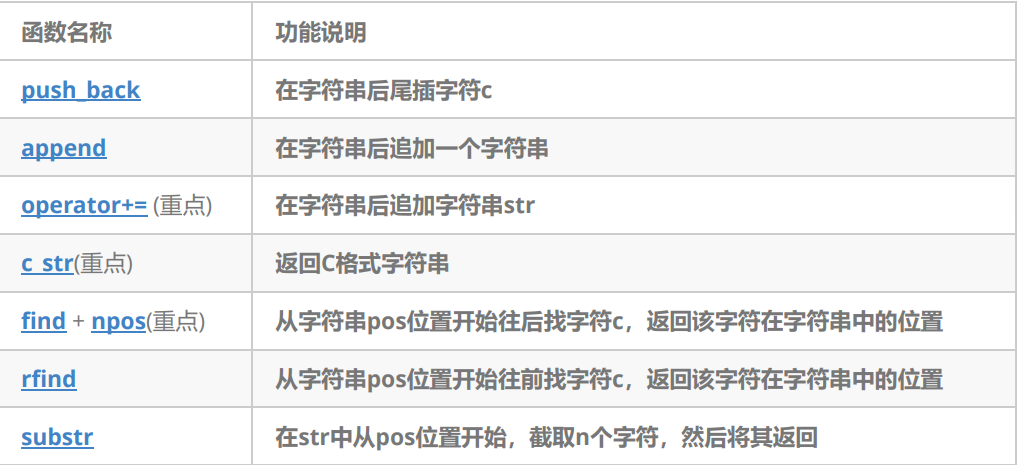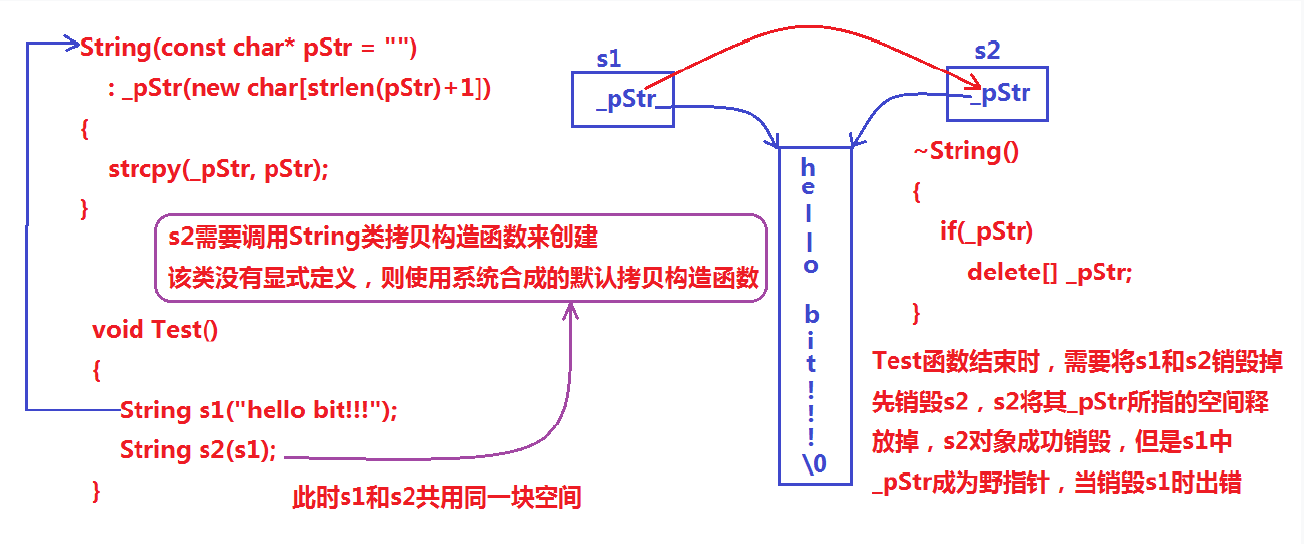1. 为什么要学习string类
1.1 C语言中的字符串
C语言中,字符串是以'\0'结尾的一些字符的集合,为了操作方便,C标准库中提供了一些str系列的库函数, 但是这些库函数与字符串是分离开的,不太符合OOP的思想,而且底层空间需要用户自己管理,稍不留神可 能还会越界访问。
2. 标准库中的string类
2.1 string类(了解)
1. 字符串是表示字符序列的类
2. 标准的字符串类提供了对此类对象的支持,其接口类似于标准字符容器的接口,但添加了专门用于操作 单字节字符字符串的设计特性。
3. string类是使用char(即作为它的字符类型,使用它的默认char_traits和分配器类型(关于模板的更多信 息,请参阅basic_string)。
4. string类是basic_string模板类的一个实例,它使用char来实例化basic_string模板类,并用char_traits 和allocator作为basic_string的默认参数(根于更多的模板信息请参考basic_string)。
5. 注意,这个类独立于所使用的编码来处理字节:如果用来处理多字节或变长字符(如UTF-8)的序列,这个 类的所有成员(如长度或大小)以及它的迭代器,将仍然按照字节(而不是实际编码的字符)来操作。
总结:
1. string是表示字符串的字符串类
2. 该类的接口与常规容器的接口基本相同,再添加了一些专门用来操作string的常规操作
。
3. string在底层实际是:basic_string模板类的别名,typedef basic_string string;
4. 不能操作多字节或者变长字符的序列。 在使用string类时,必须包含#include头文件以及using namespace std;
2.2 string类的常用接口说明(注意下面我只讲解最常用的接口)
1. string类对象的常见构造

void Teststring()
{
string s1; // 构造空的string类对象s1
string s2("hello bit"); // 用C格式字符串构造string类对象s2
string s3(s2); // 拷贝构造s3
}
2. string类对象的容量操作

string容量相关方法使用代码演示
#define _CRT_SECURE_NO_WARNINGS
#include <iostream>
using namespace std;
#include <string>
// 测试string容量相关的接口
// size/clear/resize
void Teststring1()
{
// 注意:string类对象支持直接用cin和cout进行输入和输出
string s("hello, bit!!!");
cout << s.size() << endl;
cout << s.length() << endl;
cout << s.capacity() << endl;
cout << s << endl;
// 将s中的字符串清空,注意清空时只是将size清0,不改变底层空间的大小
s.clear();
cout << s.size() << endl;
cout << s.capacity() << endl;
// 将s中有效字符个数增加到10个,多出位置用'a'进行填充
// “aaaaaaaaaa”
s.resize(10, 'a');
cout << s.size() << endl;
cout << s.capacity() << endl;
// 将s中有效字符个数增加到15个,多出位置用缺省值'\0'进行填充
// "aaaaaaaaaa\0\0\0\0\0"
// 注意此时s中有效字符个数已经增加到15个
s.resize(15);
cout << s.size() << endl;
cout << s.capacity() << endl;
cout << s << endl;
// 将s中有效字符个数缩小到5个
s.resize(5);
cout << s.size() << endl;
cout << s.capacity() << endl;
cout << s << endl;
}
//====================================================================================
void Teststring2()
{
string s;
// 测试reserve是否会改变string中有效元素个数
s.reserve(100);
cout << s.size() << endl;
cout << s.capacity() << endl;
// 测试reserve参数小于string的底层空间大小时,是否会将空间缩小
s.reserve(50);
cout << s.size() << endl;
cout << s.capacity() << endl;
}
// 利用reserve提高插入数据的效率,避免增容带来的开销
//====================================================================================
void TestPushBack()
{
string s;
size_t sz = s.capacity();
cout << "making s grow:\n";
for (int i = 0; i < 100; ++i)
{
s.push_back('c');
if (sz != s.capacity())
{
sz = s.capacity();
cout << "capacity changed: " << sz << '\n';
}
}
}
// 构建vector时,如果提前已经知道string中大概要放多少个元素,可以提前将string中空间设置好
void TestPushBackReserve()
{
string s;
s.reserve(100);
size_t sz = s.capacity();
cout << "making s grow:\n";
for (int i = 0; i < 100; ++i)
{
s.push_back('c');
if (sz != s.capacity())
{
sz = s.capacity();
cout << "capacity changed: " << sz << '\n';
}
}
}
// string的遍历
// begin()+end() for+[] 范围for
// 注意:string遍历时使用最多的还是for+下标 或者 范围for(C++11后才支持)
// begin()+end()大多数使用在需要使用STL提供的算法操作string时,比如:采用reverse逆置string
void Teststring3()
{
string s1("hello Bit");
const string s2("Hello Bit");
cout << s1 << " " << s2 << endl;
cout << s1[0] << " " << s2[0] << endl;
s1[0] = 'H';
cout << s1 << endl;
// s2[0] = 'h'; 代码编译失败,因为const类型对象不能修改
}
void Teststring4()
{
string s("hello Bit");
// 3种遍历方式:
// 需要注意的以下三种方式除了遍历string对象,还可以遍历是修改string中的字符,
// 另外以下三种方式对于string而言,第一种使用最多
// 1. for+operator[]
for (size_t i = 0; i < s.size(); ++i)
cout << s[i] << endl;
// 2.迭代器
string::iterator it = s.begin();
while (it != s.end())
{
cout << *it << endl;
++it;
}
// string::reverse_iterator rit = s.rbegin();
// C++11之后,直接使用auto定义迭代器,让编译器推到迭代器的类型
auto rit = s.rbegin();
while (rit != s.rend())
cout << *rit << endl;
// 3.范围for
for (auto ch : s)
cout << ch << endl;
}
//
// 测试string:
// 1. 插入(拼接)方式:push_back append operator+=
// 2. 正向和反向查找:find() + rfind()
// 3. 截取子串:substr()
// 4. 删除:erase
void Teststring5()
{
string str;
str.push_back(' '); // 在str后插入空格
str.append("hello"); // 在str后追加一个字符"hello"
str += 'b'; // 在str后追加一个字符'b'
str += "it"; // 在str后追加一个字符串"it"
cout << str << endl;
cout << str.c_str() << endl; // 以C语言的方式打印字符串
// 获取file的后缀
string file("string.cpp");
size_t pos = file.rfind('.');
string suffix(file.substr(pos, file.size() - pos));
cout << suffix << endl;
// npos是string里面的一个静态成员变量
// static const size_t npos = -1;
// 取出url中的域名
string url("http://www.cplusplus.com/reference/string/string/find/");
cout << url << endl;
size_t start = url.find("://");
if (start == string::npos)
{
cout << "invalid url" << endl;
return;
}
start += 3;
size_t finish = url.find('/', start);
string address = url.substr(start, finish - start);
cout << address << endl;
// 删除url的协议前缀
pos = url.find("://");
url.erase(0, pos + 3);
cout << url << endl;
}
int main()
{
return 0;
}
注意:
1. size()与length()方法底层实现原理完全相同,引入size()的原因是为了与其他容器的接口保持一 致,一般情况下基本都是用size()。
2. clear()只是将string中有效字符清空,不改变底层空间大小。
3. resize(size_t n) 与 resize(size_t n, char c)都是将字符串中有效字符个数改变到n个,不同的是当字 符个数增多时:resize(n)用0来填充多出的元素空间,resize(size_t n, char c)用字符c来填充多出的 元素空间。
注意:resize在改变元素个数时,如果是将元素个数增多,可能会改变底层容量的大 小,如果是将元素个数减少,底层空间总大小不变。
4. reserve(size_t res_arg=0):为string预留空间,不改变有效元素个数,当reserve的参数小于 string的底层空间总大小时,reserver不会改变容量大小。
3. string类对象的访问及遍历操作

string中元素访问及遍历代码演示
#define _CRT_SECURE_NO_WARNINGS
#include <iostream>
using namespace std;
#include <string>
// 测试string容量相关的接口
// size/clear/resize
void Teststring1()
{
// 注意:string类对象支持直接用cin和cout进行输入和输出
string s("hello, bit!!!");
cout << s.size() << endl;
cout << s.length() << endl;
cout << s.capacity() << endl;
cout << s << endl;
// 将s中的字符串清空,注意清空时只是将size清0,不改变底层空间的大小
s.clear();
cout << s.size() << endl;
cout << s.capacity() << endl;
// 将s中有效字符个数增加到10个,多出位置用'a'进行填充
// “aaaaaaaaaa”
s.resize(10, 'a');
cout << s.size() << endl;
cout << s.capacity() << endl;
// 将s中有效字符个数增加到15个,多出位置用缺省值'\0'进行填充
// "aaaaaaaaaa\0\0\0\0\0"
// 注意此时s中有效字符个数已经增加到15个
s.resize(15);
cout << s.size() << endl;
cout << s.capacity() << endl;
cout << s << endl;
// 将s中有效字符个数缩小到5个
s.resize(5);
cout << s.size() << endl;
cout << s.capacity() << endl;
cout << s << endl;
}
//====================================================================================
void Teststring2()
{
string s;
// 测试reserve是否会改变string中有效元素个数
s.reserve(100);
cout << s.size() << endl;
cout << s.capacity() << endl;
// 测试reserve参数小于string的底层空间大小时,是否会将空间缩小
s.reserve(50);
cout << s.size() << endl;
cout << s.capacity() << endl;
}
// 利用reserve提高插入数据的效率,避免增容带来的开销
//====================================================================================
void TestPushBack()
{
string s;
size_t sz = s.capacity();
cout << "making s grow:\n";
for (int i = 0; i < 100; ++i)
{
s.push_back('c');
if (sz != s.capacity())
{
sz = s.capacity();
cout << "capacity changed: " << sz << '\n';
}
}
}
// 构建vector时,如果提前已经知道string中大概要放多少个元素,可以提前将string中空间设置好
void TestPushBackReserve()
{
string s;
s.reserve(100);
size_t sz = s.capacity();
cout << "making s grow:\n";
for (int i = 0; i < 100; ++i)
{
s.push_back('c');
if (sz != s.capacity())
{
sz = s.capacity();
cout << "capacity changed: " << sz << '\n';
}
}
}
// string的遍历
// begin()+end() for+[] 范围for
// 注意:string遍历时使用最多的还是for+下标 或者 范围for(C++11后才支持)
// begin()+end()大多数使用在需要使用STL提供的算法操作string时,比如:采用reverse逆置string
void Teststring3()
{
string s1("hello Bit");
const string s2("Hello Bit");
cout << s1 << " " << s2 << endl;
cout << s1[0] << " " << s2[0] << endl;
s1[0] = 'H';
cout << s1 << endl;
// s2[0] = 'h'; 代码编译失败,因为const类型对象不能修改
}
void Teststring4()
{
string s("hello Bit");
// 3种遍历方式:
// 需要注意的以下三种方式除了遍历string对象,还可以遍历是修改string中的字符,
// 另外以下三种方式对于string而言,第一种使用最多
// 1. for+operator[]
for (size_t i = 0; i < s.size(); ++i)
cout << s[i] << endl;
// 2.迭代器
string::iterator it = s.begin();
while (it != s.end())
{
cout << *it << endl;
++it;
}
// string::reverse_iterator rit = s.rbegin();
// C++11之后,直接使用auto定义迭代器,让编译器推到迭代器的类型
auto rit = s.rbegin();
while (rit != s.rend())
cout << *rit << endl;
// 3.范围for
for (auto ch : s)
cout << ch << endl;
}
//
// 测试string:
// 1. 插入(拼接)方式:push_back append operator+=
// 2. 正向和反向查找:find() + rfind()
// 3. 截取子串:substr()
// 4. 删除:erase
void Teststring5()
{
string str;
str.push_back(' '); // 在str后插入空格
str.append("hello"); // 在str后追加一个字符"hello"
str += 'b'; // 在str后追加一个字符'b'
str += "it"; // 在str后追加一个字符串"it"
cout << str << endl;
cout << str.c_str() << endl; // 以C语言的方式打印字符串
// 获取file的后缀
string file("string.cpp");
size_t pos = file.rfind('.');
string suffix(file.substr(pos, file.size() - pos));
cout << suffix << endl;
// npos是string里面的一个静态成员变量
// static const size_t npos = -1;
// 取出url中的域名
string url("http://www.cplusplus.com/reference/string/string/find/");
cout << url << endl;
size_t start = url.find("://");
if (start == string::npos)
{
cout << "invalid url" << endl;
return;
}
start += 3;
size_t finish = url.find('/', start);
string address = url.substr(start, finish - start);
cout << address << endl;
// 删除url的协议前缀
pos = url.find("://");
url.erase(0, pos + 3);
cout << url << endl;
}
int main()
{
return 0;
}
4. string类对象的修改操作

注意:
1. 在string尾部追加字符时,s.push_back(c) / s.append(1, c) / s += 'c'三种的实现方式差不多,一般 情况下string类的+=操作用的比较多,+=操作不仅可以连接单个字符,还可以连接字符串。
2. 对string操作时,如果能够大概预估到放多少字符,可以先通过reserve把空间预留好。
5. string类非成员函数

上面的几个接口大家了解一下,下面的OJ题目中会有一些体现他们的使用。string类中还有一些其他的 操作,这里不一一列举,大家在需要用到时不明白了查文档即可。
6. vs和g++下string结构的说明
注意:下述结构是在32位平台下进行验证,32位平台下指针占4个字节。
vs下string的结构
string总共占28个字节,内部结构稍微复杂一点,先是有一个联合体,联合体用来定义string中字 符串的存储空间:
当字符串长度小于16时,使用内部固定的字符数组来存放
当字符串长度大于等于16时,从堆上开辟空间
union _Bxty
{
// storage for small buffer or pointer to larger one
value_type _Buf[_BUF_SIZE];
pointer _Ptr;
char _Alias[_BUF_SIZE]; // to permit aliasing
} _Bx;
这种设计也是有一定道理的,大多数情况下字符串的长度都小于16,那string对象创建好之后,内部已经有了16个字符数组的固定空间,不需要通过堆创建,效率高。
其次:还有一个size_t字段保存字符串长度,一个size_t字段保存从堆上开辟空间总的容量 最后:还有一个指针做一些其他事情。 故总共占16+4+4+4=28个字节。
 g++下string的结构
g++下string的结构
G++下,string是通过写时拷贝实现的,string对象总共占4个字节,内部只包含了一个指针,该指 针将来指向一块堆空间,内部包含了如下字段:
空间总大小
字符串有效长度
引用计数
struct _Rep_base
{
size_type _M_length;
size_type _M_capacity;
_Atomic_word _M_refcount;
};
指向堆空间的指针,用来存储字符串。
7. 牛刀小试
仅仅反转字母
class Solution
{
public:
//判断是否是字母字符
bool isLetter(char ch)
{
if(ch >= 'a' && ch <= 'z')
return true;
if(ch >= 'A' && ch <= 'Z')
return true;
return false;
}
string reverseOnlyLetters(string S)
{
//若为空直接返回
if(S.empty())
return S;
//前后交换
size_t begin = 0, end = S.size()-1;
while(begin < end)
{
while(begin < end && !isLetter(S[begin]))
++begin;
while(begin < end && !isLetter(S[end]))
--end;
swap(S[begin], S[end]);
++begin;
--end;
}
return S;
}
}找字符串中第一个只出现一次的字符
class Solution {
public:
int firstUniqChar(string s) {
// 统计每个字符出现的次数
int count[256] = {0};
int size = s.size();
for(int i = 0; i < size; ++i)
count[s[i]] += 1;
// 按照字符次序从前往后找只出现一次的字符
for(int i = 0; i < size; ++i)
if(1 == count[s[i]])
return i;
return -1;
}
};
字符串里面最后一个单词的长度--课堂练习
#include<iostream>
#include<string>
using namespace std;
int main()
{
string line;
// 不要使用cin>>line,因为会它遇到空格就结束了
// while(cin>>line)
while(getline(cin, line))
{
size_t pos = line.rfind(' '); //从后向前遍历,取得最后一个单词
cout<<line.size()-pos-1<<endl;
}
return 0;
}
验证一个字符串是否是回文
class Solution {
public:
bool isLetterOrNumber(char ch)
{
return (ch >= '0' && ch <= '9')
|| (ch >= 'a' && ch <= 'z')
|| (ch >= 'A' && ch <= 'Z');
}
bool isPalindrome(string s) {
// 先小写字母转换成大写,再进行判断
for (auto& ch : s)
{
if (ch >= 'a' && ch <= 'z')
ch -= 32;
}
int begin = 0, end = s.size() - 1;
while (begin < end)
{
while (begin < end && !isLetterOrNumber(s[begin]))
++begin;
while (begin < end && !isLetterOrNumber(s[end]))
--end;
if (s[begin] != s[end])
{
return false;
}
else
{
++begin;
--end;
}
}
return true;
}
};字符串相加
class Solution {
public:
string addstrings(string num1, string num2)
{
// 从后往前相加,相加的结果到字符串可以使用insert头插
// 或者+=尾插以后再reverse过来
int end1 = num1.size() - 1;
int end2 = num2.size() - 1;
int value1 = 0, value2 = 0, next = 0;
string addret;
while (end1 >= 0 || end2 >= 0)
{
if (end1 >= 0)
value1 = num1[end1--] - '0';
else
value1 = 0;
if (end2 >= 0)
value2 = num2[end2--] - '0';
else
value2 = 0;
int valueret = value1 + value2 + next;
if (valueret > 9)
{
next = 1;
valueret -= 10;
}
else
{
next = 0;
}
//addret.insert(addret.begin(), valueret+'0');
addret += (valueret + '0');
}
if (next == 1)
{
//addret.insert(addret.begin(), '1');
addret += '1';
}
reverse(addret.begin(), addret.end());
return addret;
}
};
3. string类的模拟实现
3.1 经典的string类问题
上面已经对string类进行了简单的介绍,大家只要能够正常使用即可。在面试中,面试官总喜欢让学生自己 来模拟实现string类,最主要是实现string类的构造、拷贝构造、赋值运算符重载以及析构函数。大家看下以 下string类的实现是否有问题?
// 为了和标准库区分,此处使用String
class String
{
public:
/*String()
:_str(new char[1])
{*_str = '\0';}
*/
//String(const char* str = "\0") 错误示范
//String(const char* str = nullptr) 错误示范
String(const char* str = "")
{
// 构造String类对象时,如果传递nullptr指针,可以认为程序非法
if (nullptr == str)
{
assert(false);
return;
}
_str = new char[strlen(str) + 1];
strcpy(_str, str);
}
~String()
{
if (_str)
{
delete[] _str;
_str = nullptr;
}
}
private:
char* _str;
};
// 测试
void TestString()
{
String s1("hello bit!!!");
String s2(s1);
}

说明:上述String类没有显式定义其拷贝构造函数与赋值运算符重载,此时编译器会合成默认的,当用s1构 造s2时,编译器会调用默认的拷贝构造。最终导致的问题是,s1、s2共用同一块内存空间,在释放时同一块 空间被释放多次而引起程序崩溃,这种拷贝方式,称为浅拷贝。
3.2 浅拷贝
浅拷贝:也称位拷贝,编译器只是将对象中的值拷贝过来。如果对象中管理资源,最后就会导致多个对象共 享同一份资源,当一个对象销毁时就会将该资源释放掉,而此时另一些对象不知道该资源已经被释放,以为 还有效,所以当继续对资源进项操作时,就会发生发生了访问违规。
就像一个家庭中有两个孩子,但父母只买了一份玩具,两个孩子愿意一块玩,则万事大吉,万一不想分享就 你争我夺,玩具损坏。


可以采用深拷贝解决浅拷贝问题,即:每个对象都有一份独立的资源,不要和其他对象共享。父母给每个孩 子都买一份玩具,各自玩各自的就不会有问题了。
 3.3 深拷贝
3.3 深拷贝
如果一个类中涉及到资源的管理,其拷贝构造函数、赋值运算符重载以及析构函数必须要显式给出。一般情 况都是按照深拷贝方式提供。

3.3.1传统版写法的String类
class String
{
public:
String(const char* str = "")
{
// 构造String类对象时,如果传递nullptr指针,可以认为程序非
if (nullptr == str)
{ assert(false);
return;
}
_str = new char[strlen(str) + 1];
strcpy(_str, str);
} String(const String& s)
: _str(new char[strlen(s._str) + 1])
{
strcpy(_str, s._str);
}
String& operator=(const String& s)
{
if (this != &s)
{
char* pStr = new char[strlen(s._str) + 1];
strcpy(pStr, s._str);
delete[] _str;
_str = pStr;
}
return *this;
}
~String()
{
if (_str)
{
delete[] _str;
_ str = nullptr;
}
}
private:
char* _str;
};3.3.2 现代版写法的String类
class String
{
public:
String(const char* str = "")
{
if (nullptr == str)
{
assert(false);
return;
}
_str = new char[strlen(str) + 1];
strcpy(_str, str);
}
String(const String & s)
: _str(nullptr)
{
String strTmp(s._str);
swap(_str, strTmp._str);
}
// 对比下和上面的赋值那个实现比较好?
String& operator=(String s)
{
swap(_str, s._str);
return *this;
}
/*
String& operator=(const String& s)
{
if(this != &s)
{
String strTmp(s);
swap(_str, strTmp._str);
}
return *this;
}
*/
~String()
{
if (_str)
{
delete[] _str;
_str = nullptr;
}
}
private:
char* _str;
};3.4 写时拷贝(了解)

写时拷贝就是一种拖延症,是在浅拷贝的基础之上增加了引用计数的方式来实现的。
引用计数:用来记录资源使用者的个数。在构造时,将资源的计数给成1,每增加一个对象使用该资源,就给 计数增加1,当某个对象被销毁时,先给该计数减1,然后再检查是否需要释放资源,如果计数为1,说明该 对象时资源的最后一个使用者,将该资源释放;否则就不能释放,因为还有其他对象在使用该资源。
3.5 string类的模拟实现
#define _CRT_SECURE_NO_WARNINGS
#include <iostream>
using namespace std;
#include <assert.h>
namespace bit
{
class string
{
public:
typedef char* iterator;
public:
string(const char* str = "")
{
_size = strlen(str);
_capacity = _size;
_str = new char[_capacity + 1];
strcpy(_str, str);
}
string(const string& s)
: _str(nullptr)
, _size(0)
, _capacity(0)
{
string tmp(s._str);
this->swap(tmp);
}
string& operator=(string s)
{
this->swap(s);
return *this;
}
~string()
{
if (_str)
{
delete[] _str;
_str = nullptr;
}
}
/
// iterator
iterator begin()
{
return _str;
}
iterator end()
{
return _str + _size;
}
/
// modify
void push_back(char c)
{
if (_size == _capacity)
reserve(_capacity * 2);
_str[_size++] = c;
_str[_size] = '\0';
}
string& operator+=(char c)
{
push_back(c);
return *this;
}
// 作业实现
void append(const char* str);
string& operator+=(const char* str);
void clear()
{
_size = 0;
_str[_size] = '\0';
}
void swap(string& s)
{
std::swap(_str, s._str);
std::swap(_size, s._size);
std::swap(_capacity, s._capacity);
}
const char* c_str()const
{
return _str;
}
/
// capacity
size_t size()const
{
return _size;
}
size_t capacity()const
{
return _capacity;
}
bool empty()const
{
return 0 == _size;
}
void resize(size_t newSize, char c = '\0')
{
if (newSize > _size)
{
// 如果newSize大于底层空间大小,则需要重新开辟空间
if (newSize > _capacity)
{
reserve(newSize);
}
memset(_str + _size, c, newSize - _size);
}
_size = newSize;
_str[newSize] = '\0';
}
void reserve(size_t newCapacity)
{
// 如果新容量大于旧容量,则开辟空间
if (newCapacity > _capacity)
{
char* str = new char[newCapacity + 1];
strcpy(str, _str);
// 释放原来旧空间,然后使用新空间
delete[] _str;
_str = str;
_capacity = newCapacity;
}
}
// access
char& operator[](size_t index)
{
assert(index < _size);
return _str[index];
}
const char& operator[](size_t index)const
{
assert(index < _size);
return _str[index];
}
// 作业
bool operator<(const string& s);
bool operator<=(const string& s);
bool operator>(const string& s);
bool operator>=(const string& s);
bool operator==(const string& s);
bool operator!=(const string& s);
// 返回c在string中第一次出现的位置
size_t find(char c, size_t pos = 0) const;
// 返回子串s在string中第一次出现的位置
size_t find(const char* s, size_t pos = 0) const;
// 在pos位置上插入字符c/字符串str,并返回该字符的位置
string& insert(size_t pos, char c);
string& insert(size_t pos, const char* str);
// 删除pos位置上的元素,并返回该元素的下一个位置
string& erase(size_t pos, size_t len);
private:
friend ostream& operator<<(ostream& _cout, const bit::string& s);
friend istream& operator>>(istream& _cin, bit::string& s);
private:
char* _str;
size_t _capacity;
size_t _size;
};
ostream& operator<<(ostream& _cout, const bit::string& s)
{
// 不能使用这个, 因为string的字符串内部可能会包含\0
// 直接cout时, 是将_str当成char*打印的,遇到内部的\0时后序内容就不打印了
//cout << s._str;
for (size_t i = 0; i < s.size(); ++i)
{
_cout << s[i];
}
return _cout;
}
}
///对自定义的string类进行测试
void TestBitstring()
{
bit::string s1("hello");
s1.push_back(' ');
s1.push_back('b');
s1.push_back('i');
s1 += 't';
cout << s1 << endl;
cout << s1.size() << endl;
cout << s1.capacity() << endl;
// 利用迭代器打印string中的元素
bit::string::iterator it = s1.begin();
while (it != s1.end())
{
cout << *it;
++it;
}
cout << endl;
// 这里可以看到一个类只要支持的基本的iterator,就支持范围for
for (auto ch : s1)
cout << ch;
cout << endl;
}






















 235
235











 被折叠的 条评论
为什么被折叠?
被折叠的 条评论
为什么被折叠?










